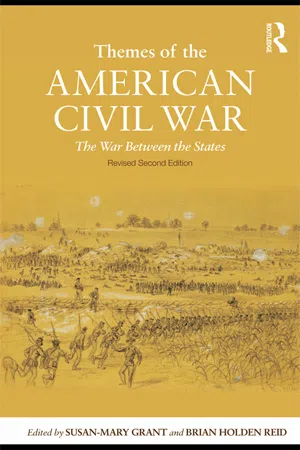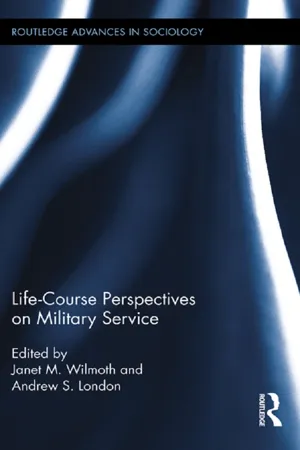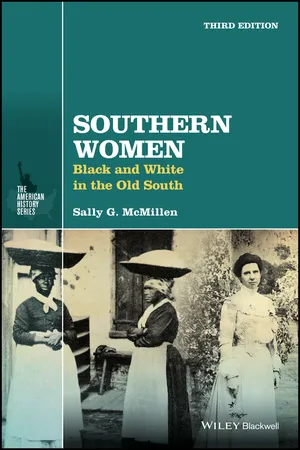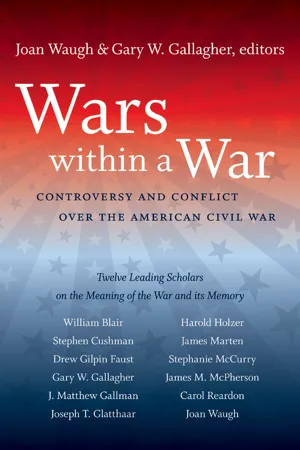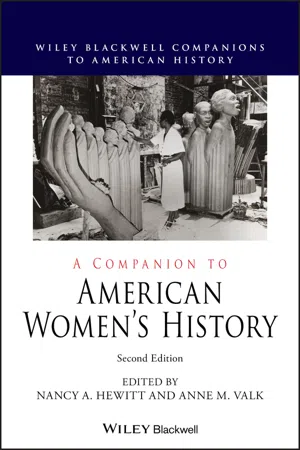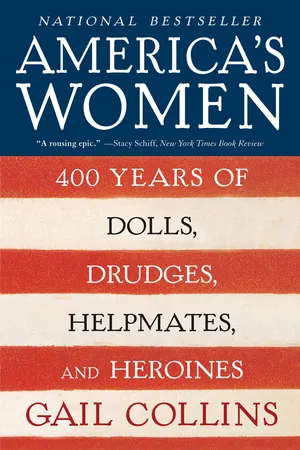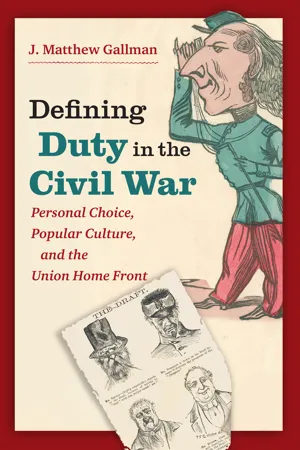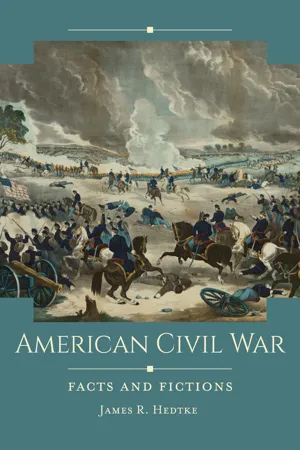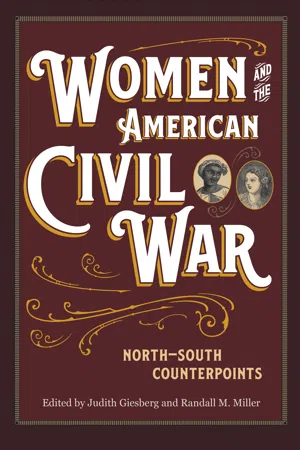History
Women in the Civil War
During the Civil War, women played significant roles by serving as nurses, spies, and in support roles for the military. They also took on responsibilities at home, managing farms and businesses while their husbands were away at war. Some women even disguised themselves as men to fight in the war. Their contributions challenged traditional gender roles and expanded opportunities for women in society.
Written by Perlego with AI-assistance
Related key terms
9 Key excerpts on "Women in the Civil War"
- eBook - ePub
Themes of the American Civil War
The War Between the States
- Susan-Mary Grant, Brian Holden-Reid, Susan-Mary Grant, Brian Holden-Reid(Authors)
- 2009(Publication Date)
- Routledge(Publisher)
Historians have, over the years, sought to challenge this paradigm in studies that highlight women’s very real contribution to the Northern and Southern war effort within the broader context of those that explore the war’s impact on women, families, and society in general. The Civil War reinforced traditional gender roles in theory, but in practice the upheaval of war produced a reformulation of the prevalent gender stereotypes of the day. The historiography of the women’s Civil War acknowledges, indeed is to a large extent structured around, this gap between ideal and reality, but it is also constrained by the limitations of the available evidence. At its most simple, the historiography of the women’s Civil War had, until quite recently, a tripartite structure, comprising: works on Northern women and the longer-term political implications of their Civil War involvement; studies of Southern women, their support—or lack thereof—for the Confederacy and their function in the development of the Lost Cause; and studies of African-American women, whose war and postwar experiences, somewhat opaque to historians as a result of fewer first-hand accounts, were couched mainly—although by no means exclusively—in the context of the changing work patterns and familial structures that freedom introduced.Of these three groups, Southern elite white women have received by far the lion’s share of scholarly attention, in part because the war affected them in such dramatic ways, in part because so many of them left written accounts of their war experience, composed either during or, more usually, after the war, but mainly because of the central role accorded such women in the war’s aftermath, as the Lost Cause emerged as a response to, in some ways a rejection of, but ultimately a means of coming to terms with, defeat. For all of these reasons, Southern women can no longer be termed the “half-sisters of history,” as Catherine Clinton once described them, but both the Northern and the African-American woman’s Civil War has been overshadowed, to a great extent, by the attention given to the Confederacy.6 - eBook - ePub
- Janet M. Wilmoth, Andrew S. London(Authors)
- 2013(Publication Date)
- Routledge(Publisher)
This chapter will focus on the impact of two different wars on women’s lives, situating women’s experiences within the broader historical events influencing their families and communities. In much of America during the 19th century, especially in the rural South, the life course of women was deeply embedded in traditional family life. This was so even during wartime, although women were often called upon to take on new roles and perform nontraditional tasks to support themselves and their families. Thus, when considering women in wartime, historians often take what might be considered a “linked lives” approach and focus on women’s roles in their families and how their lives changed as a consequence of the wartime absences of the men to whom their lives were linked. The women themselves were not in combat, but military service was less of an individual affair than a community effort. Therefore, the close link between the soldiers and the home front during the Civil War meant that men’s wartime service had a greater impact on women during the Civil War than during 20th-century wars. Nevertheless, wars have always affected women’s lives. During World War II, the increased participation of women in formal military roles and war-related industries changed the nature of war’s impact on women’s lives.THE CIVIL WARBetter social organization in the North facilitated much more complex activities by women—as typified by national organizations such as the Sanitary Commission and the United States Christian Commission. In these organizations, women played major roles and learned organizational skills that were applied after the war to charitable endeavors, as well as the prohibition and woman suffrage movements. The war did not significantly alter the life course trajectories of most women in the North, where life continued more or less as normal. The impact of absent men on families was temporary, with scarcely a ripple in terms of the pool of eligible spouses, for example (Mitchell 1995). The large volume of volunteer work undertaken by Northern women seems not to have had permanent effects beyond a few leaders (Attie 1998). The disruption caused by death and severe war wounds was profound for the women affected, but did not alter the system of widowhood, except that the widows received government pensions. - eBook - ePub
Southern Women
Black and White in the Old South
- Sally G. McMillen(Author)
- 2017(Publication Date)
- Wiley-Blackwell(Publisher)
5 Southern Women and the ConfederacyBy the time the Civil War began, southern women's hardiness had been well tested. Yet four long years of death, hardship, and sacrifices lay ahead, followed by a dozen challenging years of Reconstruction. Wars profoundly affect those on the home front, forcing women to adopt new roles and undertake greater responsibilities in the absence of men. The Civil War was no exception. Because nearly all the war was fought on southern soil, it had a greater impact on all southern women than it had on their northern counterparts.For anyone interested in understanding the female experience during the Civil War, manuscript sources are rich and extensive. Sensing the need to articulate their changing world or wanting to communicate with loved ones, a number of southern white women (at least those with the ability, time, and resources) wrote extensively. In their diaries and letters, they found an outlet to express their hopes and frustrations and share their worries, sorrows, and brief moments of elation, leaving us a profusion of diaries and letters. In addition, oral narratives from the early twentieth century provide personal insights into the lives of former slaves who, though usually young during the war, experienced the home front first hand or recalled the war's impact on their parents.The Civil War altered the South in nearly every respect and changed the lives of nearly all its women, rich and poor, black and white. The gender character of the region changed profoundly as hundreds of thousands of men left to join the Confederate Army. The mobilization of white southern men was initially high, due to patriotic fervor and a determination to whip the Yankees. Within a year, however, such excitement faded and many soldiers went home. The Confederacy then had to pass the nation's first conscription law in order to fill the ranks and force more men to serve. During four years of war, many enslaved men were forced to perform essential farm, military, and factory jobs, thus freeing more white men to take up arms. Nearly three-quarters of all eligible southern white men served in the Confederate Army at some point during the four-year conflict. - eBook - ePub
Civil War America
Controversy and Conflict over the American Civil War
- Joan Waugh, Gary W. Gallagher, Joan Waugh, Gary W. Gallagher(Authors)
- 2009(Publication Date)
- The University of North Carolina Press(Publisher)
1One consequence of war was the reconfiguration of southern political life, and particularly the way power on the home front shifted along gender lines, as white women emerged into authority and even leadership on a range of issues that lay at the very heart of popular politics in the Civil War South. Historians have routinely cited the evidence of women’s new participation without analyzing its meaning for southern political life.2 And yet the content of the archives itself testifies to a fundamental shift in the very terms and practices of political representation in the Civil War South.3 For the materials register not only the penetration of the state but also the rearrangement of household relations, local political networks, and modes of communication. Indeed, they capture the existence of a whole set of new, war-borne political identities, individual and collective, chief among them, I would propose, that of the “soldier’s wife.” There were new issues in Civil War politics but there were also new players.These are developments, I rush to say, that had nothing to do with feminism or the conscious pursuit of equal rights for women. There was no political movement in the usual sense, no national organization, and no membership or other institutional records to make our work easy.4 Rather, these developments are about the state, about the newly intimate and fraught relationship between government authorities, citizens, and subjects. The latter group included those household dependents—white women—whom the government had previously been content to access through the authority of their husbands. The political developments immediately at issue therefore concern southern white women, the vast majority of them from yeoman, poor white, or urban laborer households, pushed into the uncertainty of political practice by the deep disruption of their family and community life in the war.5 - eBook - ePub
- Nancy A. Hewitt, Anne M. Valk, Nancy A. Hewitt, Anne M. Valk(Authors)
- 2020(Publication Date)
- Wiley-Blackwell(Publisher)
Chapter Ten Women in the Civil War EraHilary GreenIn 2002, Thavolia Glymph offered an incisive analysis of the scholarship on women during the Civil War and Reconstruction eras of American history. She astutely observed that the field’s “signal challenge” remains the inclusion and accounting of the “disparate experiences of the American women in war and reconstruction” (2002: 168). She demanded an intersectional approach and suggested possible directions and frameworks for eliminating the historical silences surrounding women due to their race, class, ability, ethnicity, status, and place. By characterizing the Civil War and Reconstruction eras as the “most racially gendered and regionally segregated historiographical space in US history,” she issued a call to action (2002: 171).Scholars have paid heed and responded. While the resulting work still privileges the experiences of elite white women, the field has produced more nuanced understandings of the diversity of women’s experiences during these critical eras. More attention must be given to questions regarding the intersecting and overlapping roles of race, gender, and class in shaping the experiences of white women. And, too often, black, immigrant, and Native American women still appear as afterthoughts. Nonetheless, this review of recent critical biographies, monographs, and anthologies shows progress in the field, while making it clear that more work is necessary. Like Glymph’s earlier essay, this chapter suggests possible future thematic directions, research questions, and frameworks for understanding these women as diverse and complex.The experiences of literate women continue to shape the field even as their writings are carefully mined for insights into the diversity of women’s experiences. Scholars are beginning to employ them in fresh and novel ways; for example, elite white women are placed in dialogue with black women – specifically, Charlotte Forten, Frances Ellen Harper, and Susie King Taylor. Scholars have thus begun to counter the traditional emphasis on white women’s voices. - eBook - ePub
America's Women
400 Years of Dolls, Drudges, Helpmates, and Heroines
- Gail Collins(Author)
- 2009(Publication Date)
- William Morrow Paperbacks(Publisher)
9The Civil War: Nurses, Wives, Spies, and Secret Soldiers
“MY STATE IS OUT OF THE UNION”For Southern women, the beginning of the Civil War offered an unusual opportunity to get involved in public life. “Politics engrosses my every thought,” wrote Amanda Sims. In this crisis, showing a deep interest in masculine concerns was not considered unfeminine. Keziah Brevard, a fifty-eight-year-old widow, said she was so emotionally involved in the political drama that if she awoke in the middle of the night “my first thought is ‘my state is out of the union.’” There were the usual wartime stories of young women who refused to allow draft dodgers to pay them court. (Girls in Texas were alleged to be handing out bonnets and hoopskirts to men who failed to enlist.) But this early-stage patriotism came easy: most Americans, North and South, believed the war would be resolved very quickly, perhaps even before any blood was actually shed. When their husbands actually saddled up and rode off to battle, a number of women began questioning whether there was any cause they’d be willing to sacrifice their loved ones for. “Charlie is dearer to me than my country,” admitted Kate Rowland of Georgia.The women left behind knew they would have a new role to play, although they weren’t particularly clear what it would entail. Writing to her local paper, one Confederate urged her fellow Southern females to “hurl the destructive novel in the fire and turn our poodles out of doors, and convert our pianos into spinning wheels.” Young women wrote in their diaries that they wished they were men. Feeling both useless and anxious, they embroidered razor kits, formed relief committees to sew clothing for the troops, and held benefits to raise money for the war effort. But unlike their Revolutionary era ancestors, the Southern elite refused to wear homemade clothing as a badge of patriotic fervor. According to the Southern Illustrated News, - eBook - ePub
Civil War America
Personal Choice, Popular Culture, and the Union Home Front
- J. Matthew Gallman(Author)
- 2015(Publication Date)
- The University of North Carolina Press(Publisher)
Much as the antebellum literature provided prescriptive advice on how to behave, the wartime print culture offered guidance about proper gendered behavior for both women and men. Here again the wartime conversation shifted from peacetime prescriptions as the mix of women’s roles to be contemplated now included the role of the patriotic citizen in a new war culture. The concept of women as active contributors to a wartime cause was not new. American women had played multiple roles in supporting the cause during the American Revolution, and this patriotic legacy remained a part of national memory. Moreover, after the Revolution the new nation came to recognize and celebrate the political importance of “republican mothers” in training future generations of white male citizens. 9 But if antebellum American women understood that they had a vital political role in creating and fostering a successful republic, the immediate challenges of the Civil War were different. Ideologically engaged republican mothers had been recognized as critical in constructing a successful democratic republic. But now that the Union was threatened by war, mothers were not asked to train their sons, but to sacrifice them. Patriotic women felt moved to support the war effort, but the choices they would confront did not always yield obvious answers. 10 The interplay of individual choice and devotion to the Union is crucial here. The antebellum cultural conversation that had defined True Womanhood suggested that women—and especially young women—had various personal choices but were constrained by gendered expectations and legal statute. Those who strayed too far from prescribed behavior, so the popular fiction suggested, were liable to face disappointment, if not disaster, in their personal lives. With the coming of the Civil War, those individual choices became complicated by a collectively shared commitment to the Union - eBook - ePub
American Civil War
Facts and Fictions
- James R. Hedtke(Author)
- 2018(Publication Date)
- ABC-CLIO(Publisher)
Many factors helped to perpetuate the misconception that the Civil War was solely a man’s fight. The number of women who served in either the Confederate or Union armies was extremely small because both sides forbade females from enlisting in the military. The true number of women soldiers may never be known because women had to disguise themselves as men. Experts place the number of women in combat at somewhere between 400 and 1,000 individuals. Over 2,850,000 persons served in both armies during the war. If one uses the high end of the estimate, only 0.000045 percent of the combatants were women. Since the number of women in combat was infinitesimally small, their stories did not appear in the mainstream narrative of the war and eventually became buried in the footnotes of history.The military service of women did not affect the battles, campaigns, and outcome of the Civil War. There was no high-ranking female officer to affect tactics and strategies. Women were ordinary soldiers in an extraordinary war. As a result of women’s small numbers and lack of important roles, authors of major works about the war made little or no mention of female soldiers. In his work The Civil War, Bruce Catton does not mention female soldiers. The words “female” and “women” do not appear in the index of Shelby Foote’s three-volume work, The Civil War: A Narrative. The preeminent Civil War historian James McPherson devotes three paragraphs to female soldiers in the third edition of his text Ordeal by Fire. In most textbooks, the emphasis is on women as nurses, spies, and participants in home-front activities. In many works, authors have not included female soldiers in the combat narrative, reinforcing the misconception that the Civil War was an all-man’s fight.Women themselves either knowingly or unknowingly helped to perpetuate the misconception. Some women continued to disguise themselves as men after the war. Jennie Irene Hodgers enlisted in the Union army as Albert D. J. Cashier. Cashier served with the 95th Illinois and fought at Vicksburg, Red River, and Guntown. After the war, Cashier maintained her disguise and lived as a man until 1911. Doctors discovered her secret when they treated Cashier for injuries she suffered in a car accident. Women and their families hid their service when popular culture began to depict female soldiers as camp followers and prostitutes. The Southern lost cause apologist Gen. Jubal Early often referred to female soldiers as prostitutes. In her work Women in the Civil War - eBook - ePub
Women and the American Civil War
North-South Counterpoints
- Judith Giesberg, Randall Miller(Authors)
- 2018(Publication Date)
- The Kent State University Press(Publisher)
PARTWomen and Families
Passage contains an image
Women and Families onthe Southern Home Front
JACQUELINE GLASS CAMPBELLWith three out of four eligible men away from home fighting, the Southern home front quickly became a world of women who were challenged in ways that far exceeded and in critical ways differed from the experiences of their Northern counterparts. The enemy was on their doorstep, sometimes even within their very homes, and they faced rampant inflation, food shortages, and the breakdown of slavery. Women’s varied and diverse responses to the South’s ordeal by fire were shaped by a host of variables, including race, class, gender, geography, proximity to the enemy, and even age. Their personal dramas became central to the national drama of creating a Confederate state and sustaining slavery.1For white Southern women, regardless of their social standing, family held a central place, not only in their immediate and extended kin networks but also in defining the very structure of the Old South itself. Family was a great deal more than a biological connection; it was also a social, economic, and political structure. As such it was both the matrix and the nexus of identity for white Southern women. It also provided the model on which white Southerners built the idea of a new nation, thus projecting family interests into the heart of politics and making family a vital arbiter in defining the expectations of behavior in the service of both community and nation.2Familial and gendered language permeated the public discourse in the Civil War era. The nation was a house divided, the war was fratricidal, and the Southern states were the erring sisters. In the spring of 1861, as the country stood on the brink of war, South Carolina diarist Mary Boykin Chesnut, for one, discussed secession and war using a marriage metaphor. Chesnut wrote that North and South were now “divorced” because of incompatibility of temper and, she added sarcastically, the North was only willing to risk war to keep the Southern states because “they love us so.” But, she continued, “we are an unwilling bride.” Domestic imagery and familial language remained recurrent themes throughout a struggle that many believed was about the meaning of home.3
Index pages curate the most relevant extracts from our library of academic textbooks. They’ve been created using an in-house natural language model (NLM), each adding context and meaning to key research topics.
